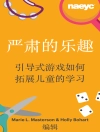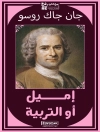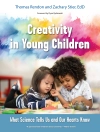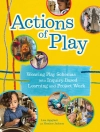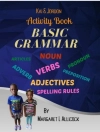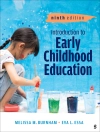After studying the current research on literacy learning for young children, delving into the beliefs and schools of Reggio Emilia, and discovering the Maker Movement, the authors created Story Making. With great success, they implemented it in their diverse and large public school district.
Story Making shares the processes, first steps, next steps, uses for materials, and lessons learned so teachers can implement their own versions in their classrooms. The book shares practical suggestions, student samples, photographs, anchor charts, and other forms of documentation.
Tabella dei contenuti
Table of Contents
Introduction
Our Wonderings
Our Day Job
Our Journey
Layout of the Book
Our Wonderings
What Does it Look Like?
What Does the Research Say?
Voices from the Field
Special Rights
Foreword
Acknowledgements
Chapter 1: What is Story Making?
Our Wonderings
What Does Story Making Look Like?
21st Century Learning
What does the Research Say about Story Making?
The Maker Cycle in Story Making
Imagine
Play
Make
Inquire
Tinker, test, and iterate
Seek out resource
Hack and repurpose
Express intention
Develop fluency
Simplify to complexify
Share
Share
Summary
Voices from the Field
Special Rights
Chapter 2: An Environment Made for Story Making
Our Wonderings
What Does an Environment Made for Story Making Look Like?
Making an Environment for Story Making
Making Time for Story Making
Materials for Story Making
How Children Engage with Materials during Story Making: Maker Cycle
Imagine
Play
Make
Share
Tips
Spaces for Story Making and Corresponding Materials
Blocks
Sculpting
Housekeeping / Dramatic Play
Art
Collage
Weaving
Tools
Tips
When Do I Begin Teaching Story Making?
Voices from the Field
Chapter 3: Creating a Culture of Inquiry
Our Wonderings
An Inquiry Story in the Making
What does the Research Say about Inquiry
Rituals and Routines for Building a Culture of Inquiry
What does a Culture of Inquiry Look Like and Sound Like
Curious learners notice
Curious learners examine materials closely
Curious learners explore
Curious learners experiment and try new ways
Curious learners persist
Curious learners collaborate and contribute
Curious learners search for new answers
Curious learners reflect
Curious learners feel joy in making discoveries
Phases of Inquiry
Phase 1
Phase 2
Phase 3
Chapter 4: A Culture in the Making
Our Wonderings
What Does A Culture in the Making Look Like?
What are the Parts, People, and Interactions in a Culture of Story Making?
What are the Parts of a Culture for Story Making?
Story Making Happens in all Parts of the Day
Who are the People in a Culture for Story Making?
Phase 1
Teacher
Choose a Real Event that the Class Experienced
Provide a Beginning to Set the Scene
Make the Story Sequentially
Child
Family
Phase II
Phase 2
Teacher
Child
Family
Phase 3
Teacher
Child
Family
What are the Interactions between the Parts and the People: Maker Cycle
Having
Making
Doing
Being
Thinking
Knowing
Sharing
Summary
Chapter 5: How to get Started with Story Making
Our Wonderings
Make Break
What does a Beginning Lesson Look Like
What does the Research Say about Effective Instruction
How do I Get Started?
Story Making Lesson: Introduction
Story Making Lesson: How to Be a Story Maker
How do I Introduce a New Material?
Story Making Inquiry Lesson: Introducing Collage
What if the Materials do not Inspire my Children Yet?
Where do Story Ideas come from?
Tips for educators with ESE, ESOL or nonverbal students
What to expect during phase 1 of your first unit?
Summary
Chapter 6: Next Steps in Story Making
Our Wonderings
What does the next step of Story Making look like?
What does the Research Say about Effective Instruction
Next steps with Story Making
What new materials or areas should we include or change to re-engage the learners?
Story Making Lesson – New Materials in our Maker Station
How to Stay Organized
Story Making Lesson – Introducing Story Maker Folders
Making a Play
Story Making Lesson – Imagine Before You Play
What Books Could help us Teach Story Making?
Story Making Lesson – How to Start Your Story
Story Making Lesson – Illustration Study on Adding Details
Tips for educators with ESE, ESOL or nonverbal students
What to expect during phase 2 of your first unit?
Summary
Make Break?
Chapter 7: Ways for Children to Communicate Their Learning
Our Wonderings
What does the Sharing Look Like in Story Making
What does the Research say about Communication
Maker’s Talks
Tips for a Successful Maker Talk
Responding to Each Others Stories
Sharing our Stories through Writing
Story Making Lesson – Taking my Story to Paper
When is it Time for my Children to Write their Stories on Paper
Story Making Lesson: How to Publish
Broaden our View of Publishing to Share with Others
We Must Celebrate!
Tips for educators with ESE, ESOL or nonverbal students
What to expect during phase 3 of your first unit?
Summary
Make Break
Chapter 8: The Role of Assessment
Our Wonderings
What is Documentation?
What does Documentation Look Like?
How do I learn to Document and Begin to put it into practice?
First Steps
Deciding to document.
Exploring Technology Use
Next STeps
Observing
Recoding
Sharing
Voices from the Field
Summary
Appendices
Circa l’autore
Robin Chappele Thompson, Ph D, has worked in education for 25 years. She has a master’s degree in elementary education, English for Speakers of Other Languages (ESOL) endorsement, certification in K-12 reading, certification in preschool education, and a Ph D in curriculum and instruction with an emphasis in childhood reading and language arts. She has been a teacher, a literacy coach, a curriculum coordinator, and an instructor at the University of South Florida. Currently, Robin works as the director of early learning in the school district of Manatee County, FL where curriculum design and implementation for Pre K–2 has been a focus area for her work.



